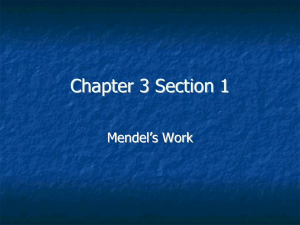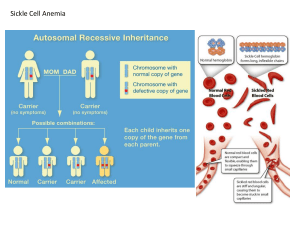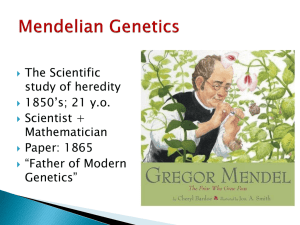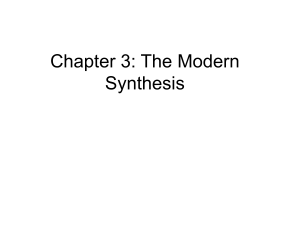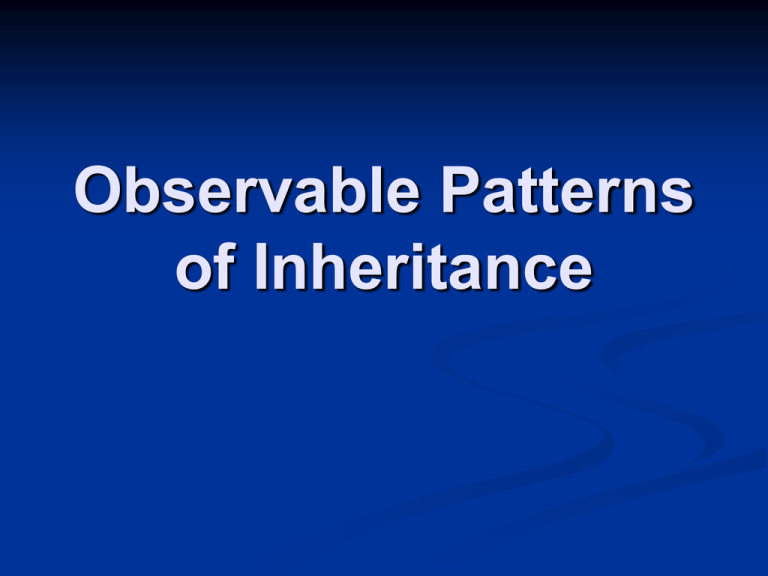
Observable Patterns
of Inheritance
Can you do this?
Terms to Know
Probability
True-breeding
Hybrid
Segregation
Traits
Genes
Homozygous
Heterozygous
Phenotype
Genotype
Dominant
Recessive
Genes
Chemical factors that determine traits
(units of information)
Analogy: Genes are like a combination of
ingredients in a recipe. They code for a
specific food.
Passed from parents to offspring
Each has a specific location (locus) on a
chromosome
Alleles
Different forms of a gene (back to
analogy…replacing jiffy p.b. with skippy
p.b.)
Dominant allele (Uppercase letter)
overrules a recessive allele (lowercase
letter) that it is paired with
Allele Combinations
Homozygous =purebred
having two identical alleles at a locus
AA (dominant expressed) or
aa
(recessive expressed)
Heterozygous =hybrid
having two different alleles at a locus
Aa (dominant expressed)
Genotype & Phenotype
Genotype refers to particular genes an
individual carries
Phenotype refers to an individual’s
observable traits
Cannot always determine genotype by
observing phenotype
Tracking Generations
Parental generation
mates to produce
P
First-generation offspring
mate to produce
F1
Second-generation offspring
F2
Earlobe Variation
Whether a person is born with attached or
detached earlobes depends on a single
gene
Gene has two molecular forms (alleles)
Earlobe Variation
You inherited one allele for this gene from
each parent
Dominant allele specifies detached
earlobes (E)
Recessive allele specifies attached
earlobes (e)
Dominant & Recessive Alleles
If you have attached earlobes, you
inherited two copies of the recessive allele
If you have detached earlobes, you may
have either one or two copies of the
dominant allele
Early Ideas About Heredity
People knew that sperm and eggs
transmitted information about traits
Blending theory
Problem:
Would expect variation to disappear
Variation in traits persists
Gregor Mendel
Strong background in
plant breeding and
mathematics
Using pea plants, found
indirect but observable
evidence of how
parents transmit genes
to offspring
Mendel was born in1822
Austrian monk
Studied at the Univ. of Vienna
Teacher (High School)
Figure 24–5 The Structure of a Flower
Section 24-1
Stamen
Anther
Filament
Ovule
Stigma
Style
Carpel
Ovary
Petal
Sepal
The Garden Pea Plant
Self-pollinating
True breeding (different alleles not
normally introduced)
Can be experimentally crosspollinated
How did Mendel
fertilize the
plants?
F1 Results of One
Monohybrid Cross
F
M
Dominant
trait is
expressed
Recessive
appears
Figure 11-3 Mendel’s Seven F1 Crosses on Pea Plants
Seed Coat
Color
Pod
Shape
Pod
Color
Smooth
Green
Seed
Shape
Seed
Color
Round
Yellow
Gray
Wrinkled
Green
White
Constricted
Round
Yellow
Gray
Smooth
Flower
Position
Plant
Height
Axial
Tall
Yellow
Terminal
Short
Green
Axial
Tall
F1 Results of Mendel’s
Dihybrid Crosses
All plants displayed the dominant form of
both traits
We now know:
All plants inherited one allele for each trait
from each parent
All plants were heterozygous (AaBb)
Principle of Dominance
Some alleles are dominant and others are
recessive.
Mendel wanted to know if the recessive
alleles disappeared or are they still in the
f1,just hidden.
Principles of Dominance
P Generation
Tall
Short
F1 Generation
Tall
Tall
F2 Generation
Tall
Tall
Tall
Short
Principles of Dominance
P Generation
Tall
Short
F1 Generation
Tall
Tall
F2 Generation
Tall
Tall
Tall
Short
Principles of Dominance
P Generation
Tall
Short
F1 Generation
Tall
Tall
F2 Generation
Tall
Tall
Tall
Short
Mendel’s Theory
of Segregation
An individual inherits a unit of information
(allele) about a trait from each parent
During gamete formation, the alleles
segregate from each other
Independent Assortment
Mendel concluded that the two “units” for
the first trait were to be assorted into
gametes independently of the two “units”
for the other trait
Members of each pair of homologous
chromosomes are sorted into gametes at
random during meiosis
Independent Assortment
Metaphase I
A
A a
a
B
B b
b
OR
A
A a
a
b
b B
B
Metaphase II:
Gametes:
A
A
a
a
A
A
a
a
B
B
b
b
b
b
B
B
B
A
B
A
1/4 AB
b
a
b
a
1/4 ab
b
A
b
A
1/4 Ab
B
a
B
a
1/4 aB
F2 Results of
Monohybrid Cross
Type of
alleles
The physical
characteristic
Impact of Mendel’s Work
Mendel presented his results in 1865
Paper received little notice
Mendel discontinued his experiments in
1871
Paper rediscovered in 1900 and finally
appreciated
Probability
The likelihood that a particular event will
occur.
Flip a coin.
We use Punnett Squares
D 38- Deduce the probable mode of
inheritance of traits (e.g.,
Punnett Squares of
Test Crosses
Homozygous
recessive
a
a
Homozygous
recessive
a
a
A
Aa
Aa
A
Aa
Aa
a
aa
aa
A
Aa
Aa
Two phenotypes
All dominant phenotype
Punnett Square of a
Monohybrid Cross
Female gametes
A
Male
gametes
a
A
AA
Aa
a
Aa
aa
Dominant
phenotype can
arise 3 ways,
recessive only
one
Test Cross
Individual that shows dominant phenotype
is crossed with individual with recessive
phenotype
Examining offspring allows you to
determine the genotype of the dominant
individual
Tt X Tt Cross
Tt X Tt Cross
Tt X Tt Cross
Genetics Practice Problem 1
What occurs when a purple plant that is
heterozygous is fertilized by a white plant?
Identify generations
Punnett Square
Genotypes %
Phenotype %
Principle of Independent
Assortment
The genes for different traits separate
independently of one another during the
formation of gametes.
Figure 11-10 Independent Assortment in Peas
Yellow round
Green round
Yellow wrinkled
Green wrinkled
9 : 3 : 3 : 1 Ratio
9/16
3/16
3/16
1/16
Dihybrid Cross
Experimental cross between individuals
that are homozygous for different
versions of two traits
Straight Pinky
(Dominant)
Bent Pinky
(Recessive)
Straight Thumb
(Dominant)
Curved Thumb
(Recessive)
More Dominant Traits
Polydactylism
Achondroplastic
Dwarfism
Tay-Sachs Disease - One Wrong Letter
Dominance Relations
Complete dominance
Incomplete dominance
Heterozygote phenotype is somewhere
between that of two homozyotes
Codominance
Non-identical alleles specify two phenotypes
that are both expressed in heterozygotes
Flower Color in
Snapdragons: Incomplete
Dominance
Red-flowered plant X White-flowered plant
(homozygote)
(homozygote)
Pink-flowered F1 plants
(heterozygotes)
Flower Color in Snapdragons:
Incomplete Dominance
Red flowers - two alleles allow them to
make a red pigment
White flowers - two mutant alleles; can’t
make red pigment
Pink flowers have one normal and one
mutant allele; make a smaller amount of
red pigment
Figure 11-11 Incomplete Dominance in Four O’Clock Flowers
Figure 11-11 Incomplete Dominance in Four O’Clock Flowers
Flower Color in Snapdragons:
Incomplete Dominance
Pink-flowered plant X Pink-flowered plant
(heterozygote)
(heterozygote)
White-, pink-, and red-flowered plants
in a 1:2:1 ratio
Incomplete Dominance
Neither allele
is dominant
over the other
Combination
of red and
white
flowers
Codominant
Sickle Cell Disease
ABO Blood Types
Pleitropy
Alleles at a single locus may have effects
on two or more traits
Classic example is the effects of the
mutant allele at the beta-globin locus that
gives rise to sickle-cell anemia
Teachers Domain - A Mutation Story
Genetics of Sickle-Cell
Anemia
Two alleles
1) HbA
Encodes normal beta hemoglobin chain
2) HbS
Mutant allele encodes defective chain
HbS homozygotes produce only the
defective hemoglobin; suffer from sicklecell anemia
Pleiotrophic Effects of
HbS/HbS
At low oxygen levels, cells with only HbS
hemoglobin “sickle” and stick together
This impedes oxygen delivery and blood
flow
Over time, it causes damage throughout
the body
Blood Typing
Karl Landsteiner 1897
Worked at the Univ. of Vienna, Vienna
Austria (Sound familiar?)
Wanted to find out which red blood cells
would clot
First found two different groups, A and B
Third group would not clot when exposed
to A or B What do you think this was?
What about the forth group?
Genetics of ABO Blood Types:
Three Alleles
Gene that controls ABO type codes for
enzyme that dictates structure of a
glycolipid on blood cells
Two alleles (IA and IB) are codominant
when paired
Third allele (i) is recessive to others
ABO Blood Type:
Glycolipids on Red Cells
Type A - Glycolipid A on cell surface
Type B - Glycolipid B on cell surface
Type AB - Both glyocolipids A & B
Type O - Neither glyocolipid A nor B
ABO Blood Type:
Allele Combinations
Type A - IAIA or IAi
Type B - IBIB or IBi
Type AB - IAIB
Type O - ii
ABO and Transfusions
Recipient’s immune system will attack
blood cells that have an unfamiliar
glycolipid on surface
Type O is universal donor because it has
neither type A nor type B glycolipid
Codominance and Multiple
Alleles - AB or NOT AB
Codominance - both alleles are dominant
IA and IB
Multiple Alleles - genes have more than two
alleles
IA, IB, Ia
Figure 14-4 Blood Groups
Phenotype
(Blood Type
Genotype
Antigen on
Red Blood Cell
Safe Transfusions
To
From
Universal
Acceptor
Universal
Donor
Rh factor - Another Blood
Trait
Pregnancy complications
Rh is a type of protein in the blood
If an Rh- man reproduces with an Rh +
woman complications can occur.
Polygenic Traits: Desiree’s
Baby Case Study
More than one gene controls a trait
Skin color more than one gene,
incomplete dominance
A,B and C are dark
a,b and c are light
Sex Linked Traits - traits
that are carried on the either
the x or y chromosome
Figure 14-13 Colorblindness
Father
(normal vision)
Colorblind
Normal
vision
Male
Female
Daughter
(normal vision)
Son
(normal vision)
Daughter
(carrier)
Son
(colorblind)
Mother
(carrier)
Figure 14-13 Colorblindness
Father
(normal vision)
Colorblind
Normal
vision
Male
Female
Daughter
(normal vision)
Son
(normal vision)
Daughter
(carrier)
Son
(colorblind)
Mother
(carrier)
Colorblindness
Sex-Linked Disorder
Cystic Fibrosis - Finding Cures is Hard
Male Pattern
Baldness (X
chromosome)
Hairy Pinna - long
hair on ears
Recessive Disorder
Figure 14-8 The Cause of Cystic Fibrosis
Chromosome
#7
CFTR
gene
The most common allele
that causes cystic fibrosis is
missing 3 DNA bases. As
a result, the amino acid
phenylalanine is missing
from the CFTR protein.
Normal CFTR is a chloride
ion channel in cell
membranes. Abnormal
CFTR cannot be transported
to the cell membrane.
The cells in the person’s airways
are unable to transport chloride
ions. As a result, the airways
become clogged with a thick
mucus.
Albinism
Phenotype results when pathway for
melanin production is completely blocked
Genotype - Homozygous recessive at the
gene locus that codes for tyrosinase, an
enzyme in the melanin-synthesizing
pathway
Human Genetics
Tracing Genes Through
Families - Human Pedigrees
Female
Partner
Male
Brothers and
Sisters
Figure 14-3 A Pedigree
A circle represents
a female.
A horizontal line connecting
a male and female
represents a marriage.
A half-shaded circle
or square indicates
that a person is a
carrier of the trait.
A completely
shaded circle or
square indicates
that a person
expresses the
trait.
A square represents
a male.
A vertical line and a
bracket connect the
parents to their children.
A circle or square
that is not shaded
indicates that a
person neither
expresses the trait
nor is a carrier of
the trait.
Ability to roll
the tongue in
the Senator
Family
Tongue Roller - dominant, Non-Tongue Roller - recessive
White = tongue roller, Purple = non-roller
What are the genotypes of everyone? R = roller, r = non roller
George, Sam, Ann, Michael, Daniel and Alan are Rr
Arlene, Tom, Wilma, and Carla are rr
Sandra, Tina and Christopher are either RR or Rr
Case Study - Hemophilia and
the Royal Family
1. First, let’s take a look at Queen Victoria’s son Leopold’s family. His daughter,
Alice of Athlone, had one hemophilic son (Rupert) and two other children—a boy
and a girl—whose status is unknown. a) What is the probability that her other son
was hemophilic? b) What is the probability that her daughter was a carrier?
Hemophilic? c) What is the probability that both children were normal?
2. Now for the Spanish connection: Victoria’s youngest child, Beatrice, gave birth to
one daughter, one normal son, and two hemophilic sons. Looking at the pedigree of the
royal family, identify which of Beatrice’s children received the hemophilic gene; why
can you make this conclusion? Notice that Beatrice’s daughter, Eugenie, married King
Alfonso XIII of Spain and had six children, one of whom was the father of Juan Carlos,
the current King of Spain. Would you predict that Juan Carlos was normal, a carrier, or
a hemophilic?
3. Alexis did not die from hemophilia. At the age of fourteen he was executed with the
rest of the family. His four oldest sisters were also young and didn’t have children, so
we don’t know whether any of them was a carrier. But we can make an estimate. a)
What are the probabilities that all four of the girls were carriers of the allele
hemophilia? b) Supposing Alexis had lived and married a normal woman, what are the
chances that his daughter would be a hemophiliac? c) What are the chances his
daughters would be carriers? d) What are the chances that his sons would be
hemophiliacs?
Nondisjunction
Homologous
chromosomes
fail to separate
Meiosis I:
Nondisjunction
Meiosis II
Nondisjunction
Homologous
chromosomes
fail to separate
Meiosis I:
Nondisjunction
Meiosis II
Nondisjunction
Homologous
chromosomes
fail to separate
Meiosis I:
Nondisjunction
Meiosis II
Epistasis
Interaction between the products of gene
pairs
Common among genes for hair color in
mammals
Genetics of Coat Color in
Labrador Retrievers
Two genes involved
- One gene influences melanin production
Two alleles - B (black) is dominant over b
(brown)
- Other gene influences melanin deposition
Two alleles - E promotes pigment deposition
and is dominant over e
Allele Combinations
and Coat Color
Black coat - Must have at least one
dominant allele at both loci
BBEE, BbEe, BBEe, or BbEE
Brown coat - bbEE, bbEe
Yellow coat - Bbee, BbEE, bbee
Comb Shape in Poultry
Alleles at two loci (R and P) interact
Walnut comb - RRPP, RRPp, RrPP, RrPp
Rose comb - RRpp, Rrpp
Pea comb - rrPP, rrPp
Single comb - rrpp
Campodactyly:
Unexpected Phenotypes
Effect of allele varies:
Bent fingers on both hands
Bent fingers on one hand
No effect
Many factors affect gene expression
Continuous Variation
A more or less continuous range of small
differences in a given trait among
individuals
The greater the number of genes and
environmental factors that affect a trait, the
more continuous the variation in versions
of that trait
Human Variation
Some human traits occur as a few discrete
types
Attached or detached earlobes
Many genetic disorders
Other traits show continuous variation
Height
Weight
Eye color
Temperature Effects
on Phenotype
Himalayan rabbits are
Homozygous for an allele
that specifies a heatsensitive version of an
enzyme in melaninproducing pathway
Melanin is produced in
cooler areas of body
Environmental Effects on
Plant Phenotype
Hydrangea macrophylla
Action of gene responsible for floral
color is influenced by soil acidity
Flower color ranges from pink to blue



